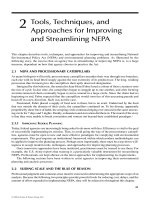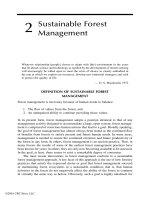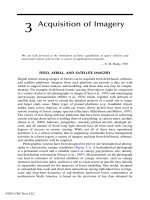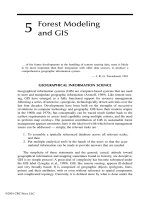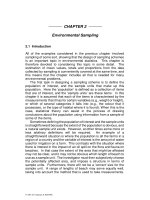GIS for Coastal Zone Management - Chapter 2 pot
Bạn đang xem bản rút gọn của tài liệu. Xem và tải ngay bản đầy đủ của tài liệu tại đây (409.71 KB, 10 trang )
CHAPTER TWO
Bridging the Land-Sea Divide Through
Digital Technologies
Simon Gomm
2.1 INTRODUCTION
There are many different types of users of coastal zone information, from the
casual user who may only want to browse, to the sophisticated user who makes
frequent use of mapping and demands continuous improvement. These user
communities are diverse in the topics they address, covering such areas as Local
and Central Government, environmental and economic analysis, and also
increasingly leisure use.
A common mapping framework that bridges the land-sea divide allows users
to build applications and decision-making tools necessary to
promote the shared
use of such data throughout all levels of Government, the private and non-profit
sectors and academia. A consistent framework also serves to stimulate growth,
potentially resulting in significant savings in data collection, enhanced use of data
and assist better decision-making.
As well as a physical division, the land-sea divide has also, for many spatial
data suppliers, acted as a limit to their area of responsibility, or formed a data
product boundary. As a result users wanting to model the diverse aspect of the
coastal zone across this divide have had to identify, obtain and combine separate
datasets to provide the data coverage they require. The combination process must
resolve integration problems resulting from the differing projections, scale of
capture and other specification issues of the source datasets. This process can be
time consuming, result in inconsistent data and can cause a hindrance to the
management of a particularly sensitive environmental zone.
This chapter will look at the technical issues involved with the integration of
data across the land-sea divide and identify means for resolving these. Examples
within this chapter have been drawn from the work done by Ordnance Survey of
Great Britain, United Kingdom Hydrographic Office and the British Geological
Survey on integrated coastal zone mapping project (ICZMap) (Gomm, 2001).
© 2005 by CRC Press LLC
2.2 DATA SPECIFICATIONS
At the commencement of a project the user will need to have assessed the project’s
spatial and non-spatial requirements, and these will provide the key criteria for
defining and selecting suitable data. Typically such criteria will include: physical
extent of the project area, data content, attribution, positional accuracy, spatial
resolution, currency, projection, datum and transfer format. These criteria are all
discussed in more detail below.
2.2.1 Spatial Extent
The extent of the area for which data are required needs to be defined clearly in the
coordinate system to be used in the project. At a minimum the extent should be
defined by a bounding rectangle using the x and y coordinates of 2 diagonal
corners. Ideally the extent should be delineated by a bounding polygon at an
appropriate spatial resolution. A bounding polygon will allow for better selection
of relevant information and itself provide a tool for analysis within the project. In
defining the extent a sufficient margin should be included to allow for inclusion of
features which may have an influence on the application.
Figure 2.1 Bounding Rectangle. © Crown Copyright 2004. All rights reserved.
Figure 2.2 Bounding Polygon. © Crown Copyright 2004. All rights reserved.
© 2005 by CRC Press LLC
In Figure 2.1 the extent of the ICZMap coastal zone project is defined as a
simple bounding rectangle and in Figure 2.2 as a polygon defined by buffering the
coastline 20km offshore and 5km inland. In practice, the latter was more
appropriate for the application and datasets of the ICZMap project, with its
emphasis on the processes and dynamics of the land-sea interface.
Whilst it is normal to consider defining extent only in two dimensions, it is
worth noting that there will be applications where height/depth extents, along with
the temporal aspect may need to be specified.
2.2.2 Data Content
The use to which data are to be put will define the features that are required. At the
simplest level this may merely be raster imagery for use as backdrop mapping
within an application. At a more complex level, where the data are required to
form part of the analysis, the user will need to consider what features and object
classes are required. In defining these requirements there will be some features that
fall uniquely on the land or in the sea, but there will also be others that by their
nature bridge this land-sea divide.
2.2.3 Attribution
Attribution of features within a dataset can be at a number of different levels. As a
minimum this could take the form of feature coding, allowing selection of required
features for analysis and symbolisation. Beyond this, additional attribution
concerning the real-world properties of the feature and how it was captured will
increase the versatility of the data. These attributes will vary for different features
within a dataset depending on the real-world object they represent, and the uses for
which the dataset was intended.
2.2.4 Positional Accuracy and Spatial Resolution
An appreciation of the positional accuracy requirements of a dataset is important to
ensure that the data are used in an appropriate way with other datasets, and to put
results of any analysis in to the correct context. The positional accuracy of spatial
data can be expressed both in terms of its absolute accuracy and its relative
accuracy.
Absolute accuracy is a measure to which a coordinated position in the dataset
corresponds to the true position of the real world feature it represents. Relative
accuracy expresses the positional accuracy between points in a dataset, and is a
comparison of the distance between features in a dataset with the real world
distance. Datasets with a high relative accuracy but low positional accuracy may
indicate a systematic shift in the data with respect to the coordinate system.
The spatial resolution represents the coordinate precision to which data are
stored in the dataset, and affects the maximum achievable accuracy for a dataset,
© 2005 by CRC Press LLC
e.g. if the spatial resolution is only 10m then this could affect the absolute
accuracy of a point by up to 7m.
2.2.5 Currency
Currency is sometimes overlooked as an aspect of a dataset’s specification.
Attribution should ideally allow for the recording of temporal information at
feature level. This can include creation date, capture date and modification date
(with nature of modification). Occasionally, temporal information will be limited
to the date of the dataset’s last update. The temporal information is important both
from an analysis point of view, but also for the initial selection of data for the
project. For example, the ability to select the position of the top and bottom of
coastal slopes for a given year can allow predictive analysis of coastal erosion
processes to be studied.
2.2.6 Projections and Datum
Coordinates within a dataset will be relative to a given projection and datum. Map
projections attempt to represent the curved surface of the Earth on a flat plane. All
projections are approximations and some will better represent large areas of the
world, albeit with large distortions, while others are more suitable for small
specific areas with much smaller distortions.
A geodetic datum or spheroid is a mathematical approximation of the surface
of the Earth, which itself is an imperfect sphere. Numerous geodetic datums have
been calculated over the years, some suitable for global applications and others
calculated to minimise errors on a country-by-country basis.
Height datum represents a base level from which elevations are measured
and each information source may have its own. Datasets on land will often share a
common height datum (e.g. use of Ordnance Survey Newlyn Datum in Great
Britain); however different datums will usually be used for marine datasets.
Frequently, with marine datasets having their origin from navigation charts, depth
values will be typically based on local lowest astronomic tide values.
For a project it is important to determine what projection and datum are most
suitable for the application, and to ensure that you are aware of what the
projections and datum of the source datasets are.
2.2.7 Data Transfer Format
Datasets are transferred between media using a chosen transfer format. Whilst
there is no single common transfer format there are a number of commercial ones,
such as Autodesk-AutoCAD DXF, ESRI Shapefile and MapInfo TAB and
MIF/MID formats, which are becoming more widely adopted as de facto
standards. Such formats can be limited as they are primarily intended for transfer
between users of the same software. When read by other software, information
may be lost due to data model differences.
© 2005 by CRC Press LLC
Ideally a neutral, non-software-specific, transfer format is needed. Many
attempts have been made to try to implement these, one of the most recent
examples being GML (Geography Markup Language) promoted by the OpenGIS
consortium as a development of the more widely used XML Web document
markup language. However, in practice, the software being used for a project may
act as a limiting factor in what formats it can and cannot read.
2.2.8 Metadata
Much of the information describing a dataset should be included in its metadata if
present. As well as accompanying a dataset, metadata are now frequently being
held on readily accessible databases, allowing users to identify datasets suitable to
their requirements. The international standard for digital geospatial metadata (ISO
19115) is now being adopted by many national bodies, such as US Federal
Geographic Data Committee (FGDC) for its Content Standard for Digital
Geospatial Metadata (CSDGM) (
and the UK’s Association for Geographic Information (AGI) with its GIGateway
project ( />2.3 DATA SELECTION
The properties of datasets that have been outlined above cover some of the points
that need to be considered in establishing a project and specifying data
requirements. Metadata services provide a tool for locating data, but they will not
tell you if they are best suited for your purposes. It is unlikely that any dataset will
fully match your requirements, but what should be considered is the ability to
integrate and modify them to satisfy your needs. Typically, more flexible datasets
will have a richness of feature classes and attribution, and good positional
accuracy, but these will come at an increase in cost and data volumes.
2.4 DATA INTEGRATION
It is unlikely that a single dataset will satisfy the full needs of a project. This is
particularly true when modelling the coastal zone, where there is likely to be one
source for the land, another for the sea and potentially other subsidiary datasets
straddling both. In these cases there will inevitably be some data integration issues.
Typical problems and potential solutions are discussed here.
2.4.1 Differences in scale
Datasets which have been captured from graphic products can be said to have a
nominal scale at which they were intended to be used. In these datasets,
differences in scale will show themselves in the positional accuracy and spatial
resolution, as well as in the features and attributes that are present e.g. field
© 2005 by CRC Press LLC
boundaries may be shown at a scale of 1:25,000 but not at 1:50,000. At smaller
scales data will also normally have been generalised, simplifying the geometry of
the features. These factors are not a problem in themselves, as long as the data
meet application requirements, but problems do nonetheless occur when trying to
join together data captured at different scales.
The following example illustrates the relevance of this to the coast, using
datasets from the Ordnance Survey of Great Britain and from the UK
Hydrographic Office respectively.
In Figure 2.3 the landward data have been captured at a scale of 1:2,500 and
on the seaward side at a scale of 1:25,000 (this being the highest resolution data
available for the area). The result of this is a disparity in the features common to
both zones, and a greater density of detail on the land compared with the sea. In
such situations a choice can sometimes be made as to which feature is most useful
to the application, and the software system functionality used to remove or
suppress the other. In a similar way features that are superfluous to the application
can also be removed or suppressed by the software, provided that features can be
distinguished from each other by their attributes.
If the geometry of the large-scale data is too complex, then filtering this
using line-simplification or other generalisation algorithms can be considered.
Within a project for a user this is probably only appropriate to features where line
vertices can be removed whilst keeping the basic shape of the feature.
Figure 2.3 Overlay of hydrographic and terrestrial datasets. © Crown Copyright 2004. All rights
reserved.
© 2005 by CRC Press LLC
2.4.2 Projection
Where the datasets to be used are in different projections a choice will have to be
made as to which to use, based on the application and the type of output required.
Transformation facilities, with parameters to convert between most common map
projections, are supplied with mainstream GIS packages. For projections not
included these can also be transformed, provided the parameters defining the
projection are known.
How the transformation is applied depends on the functionality of the
software being used. Frequently this will allow transformation of data coordinates
to be done either as a permanent process, storing new coordinates for the features
in the new projection, or as a real-time transformation when the dataset is required
for display or analysis.
2.4.3 Currency
Where different datasets abut each other or overlap, the same real-world features
may be represented in both datasets. In such cases a decision will normally need to
be made as to which features to retain. Such selection may be done on the currency
of the data i.e. the date of capture of the feature. However, this may not give the
best quality in terms of fidelity or resolution. In these situations the final decision
as to whether the feature gets included will be based on the specific needs of the
application.
2.4.4 Accuracy
As with currency, an appreciation of the relative positional accuracies of datasets
that are to be integrated will ensure that data are combined in an appropriate
manner. Where features representing the same real-world objects exist in two or
more datasets, the positional accuracy will offer one means of selecting which to
keep. In some instances it will not be appropriate just to take the data with the
highest positional accuracy. For some applications the more accurate data may take
up more space, be slower to manipulate, and not enhance the analysis, so
ultimately it is up to the user to decide what best fits their needs.
2.4.5 Data Overlap
Many of the issues discussed above cover situations where data in different
datasets overlap spatially and represent the same real world objects. It is assumed
that in such situations a decision will need to be made as to which features to keep,
and that this selection will be driven by the requirements of the application. In the
case of a marine and a terrestrial dataset bounded by a coastline, due to the
different representations of the coastline in the two datasets, features may overlap
(as shown in Figure 2.4).
© 2005 by CRC Press LLC
These overlaps can be treated in a number of ways:
1) Ignore them, accepting that both overlapping features are valid in the context of
the source datasets and their specifications. This may not be a real solution when
the application requires a single seamless layer of information with no duplication
of common features.
2) Spatially intersect overlapping features and retain all the features that result.
Features will be split by others that overlap them and the resulting features will
need to retain the attributes of both source datasets to be flexible. This is the most
flexible solution but has a potential storage overhead of having to store the two
sets of attributes.
3) Spatially intersect overlapping features and retain only one set of features. This
will ensure no overlap, but some features will be truncated or split and as a result
may present problems when used for analysis.
4) Edit datasets together using a single boundary between them. This can be
labour-intensive, but will give the best solution. However, if datasets are updated
independently then this work will need to be repeated to maintain currency of the
combined dataset.
Figure 2.4 Data overlap example. © Crown Copyright 2004. All rights reserved.
© 2005 by CRC Press LLC
2.4.6 Height Datum Correction
2D plan data need not necessarily be physically combined into a common dataset
to be of use. This is not true in the case of 3-dimensional data. Terrestrial and
marine elevation data can be displayed graphically in 2D, but where any use of
terrain modelling is required, such as for an analysis of the inter-tidal zone, a
combined height model needs to be created. As mentioned previously, the
terrestrial and marine elevation data will frequently be relative to different datums.
As a result, prior to combining them into a single height model, one or more of the
datasets need to be corrected to the other’s datum as well as any re-projection of
the data onto the other’s coordinate system (Milbert and Hess, 2001).
In the simpler cases, correction of a datum can be achieved by a single
difference applied to all elevation values in a dataset, but more frequently the
difference will vary across an area. In the case of UK Hydrographic Office
(UKHO) data, bathymetric values are based on lowest astronomic tides for
navigation purposes, as computed for specific locations on each chart. The
relationships between these different datums are shown in Figure 2.5.
There is a complex and varying relationship between Ordnance Survey of
Great Britain’s single, standard Newlyn height datum (which applies to all
terrestrial mapping by the OS) and the values used in Hydrographic charting, with
the latter differing widely along the coast, due to the varying tidal conditions that
occur. To convert the UKHO bathymetry values to Newlyn datum, a surface of
differences has to be created so that correction value can be calculated for all
points (Capstick & Whitfield, 2003). Once a surface of differences has been
created this can be used to interpolate values for all bathymetry points. The
corrected points can then be used with the terrestrial elevation data to generate an
integrated land-sea model for display and analysis.
Figure 2.5 Datum Relationships. © Crown Copyright 2004. All rights reserved.
© 2005 by CRC Press LLC
Figure 2.6 shows a representation of integrated elevation data for the Isle of
Wight, UK, with the bathymetry information coming from UKHO sounding values
and the terrestrial elevation from Ordnance Survey Land-Form PROFILE contours
and spot heights.
2.5 CONCLUSIONS
Whilst there may be limited availability of single datasets covering the land-sea
divide, digital technologies offer the capabilities to combine and resolve available
adjacent datasets to satisfy diverse applications for the coastal zone. In satisfying
an application, the user must have a clear specification for their data requirements
so as to be able to assess the suitability of candidate datasets, and the issues that
are likely to be encountered in their integration. Although not exhaustive, this
chapter has attempted to highlight the main areas to be addressed in the selection
and integration of spatial datasets for the coastal zone.
2.6 REFERENCES
Capstick, D. and Whitfield, M., 2003, Height integration at the coastal zone. In
Proceedings of the GIS Research UK, 11
th
Annual Conference 2003.
Gomm, S., 2001, Integrated mapping of the marine and coastal zone. In
Proceedings of the GIS Research UK, 9
th
Annual Conference 2001.
Milbert, D.G. and Hess, K.W., 2001, Combination of topography and bathymetry
through application of calibrated vertical datum transformations in the Tamapa
Bay region. In Proceedings of the 2
nd
Biennial Coastal GeoTools Conference
2001.
Figure 2.6 Integrated Height Model. © Crown Copyright 2004. All rights reserved.
© 2005 by CRC Press LLC

